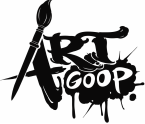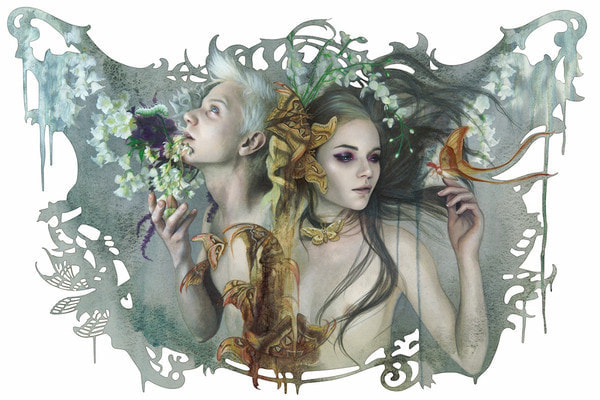|
1. Who were your teachers or influences?
For technique I’m primarily self-invented, since the art school I attended (Cornish College of the Arts) focused more on the conceptual than the technical. As a result, my process is based on experimentation. My painting technique involves many steps developed over years of experimenting with combining different media, and I would consider myself an “image maker” rather than a traditional “painter”. I also incorporate lots of other creative outlets into my work like reference photography, prop-building, and fashion styling on the way to each final piece. My early stylistic influences were cartoons & anime, Art Nouveau and Rococo, Fashion Magazines & Designers (especially Alexander McQueen), Glam Rock, Tibetan Thangka Painting, and a deep obsession with science and natural history. 2. What techniques or tricks did you find most useful when learning to make art? Embrace the mediums that feel most natural to you! Watercolor was the first medium I ever learned and feels very intuitive to me, but I struggled with oil and acrylic painting on their own before finding a way to integrate watercolor into my process. Sealing a watercolor piece with an acrylic varnish & then finishing it in oils, or doing the same with a print transfer, helped me get the most out of each medium. https://vimeo.com/90705649 3. What are 3 key principles of making good art, in your opinion? 1. Care about what you are making with every inch of your being 2. Think about the “why” as well as the “how” 3. Don’t be afraid to try new things, and even fail 4. What are the most common mistakes that you see other artists make? Relying too heavily on cliche or aesthetic formulas. We all stumble across elements that “work” in the sense that they are easily accessible and popular, but if you stick too tightly to these devices, the art ends up feeling predictable. Try things that scare you, try things that make you uncomfortable or that you don’t know how to resolve. That’s where the work gets exciting! 5. Can you break your artistic process down into 10 steps (or less) for us? 1. The Concept: A vague idea and a super rough thumbnail. Often I’ll also make a digital color swatch that captures the “mood” or emotion of the idea. 2. Preparation: I usually start by building props & accessories for the reference photoshoot. Sometimes this is simple, like constructing a small wreath or mask out of flowers. Sometimes its complex, like filling an acrylic mannequin with flowers or constructing an elaborate costume. 3. Reference Photoshoot: Previously these have been in a studio setting where I can control the lighting and props, but recently shoots have been outdoors too. I love playing with warm/cool accent lights that give directional colors to the piece. Often during the shoot the model also contributes something unexpected that that enriches the idea, but sometimes the images turn out just like my initial concept. 4. Layout & Underdrawing: I finalize the composition in photoshop & sketch an underdrawing. Usually this is a quick outline-tracing from the photo to ground the lines & proportions. Sometimes the drawing is printed lightly onto watercolor paper to avoid the need for a messy transfer or projection. 5. Watercolor Underpainting: The “underpainting” or “study” of the piece. This creates the bones of the final painting, and establishes basic color, form, mood, etc. The watercolor is often smaller in scale than the final piece, and may not be fully rendered in detail, its just a stepping- stone for the oils and takes the place a base-layer would in a traditional painting process. 6. Scan the watercolor, make any small tweaks it needs digitally (removing minor blemishes, changing a particular color slightly, extending textures on edges to fill laser cut frame). Design the unique lasercut frame to match the particular image. 7. Print the watercolor underpainting on a thin archival rice paper & mount it to gessoed panel, sealing it with acrylic coatings (like GAC 800 and matte medium). I’ve used both thin masonite wood and clear and colored acrylic panels. 8. Lasercut the Panel: I work with a variety of Makerspaces, and generally use 100-120 Watt CO2 Laser Cutters. 9. Oils: I build up and finish the painting in oil paint layers and glazes. This is the most time consuming part of my process. While the bones of the painting are firmly in place before I begin in oils, this stage is like the muscle and skin of the final piece. Most of the depth, nuance and detail happens here. Lately I’ve been playing with heavier knife textures in the backgrounds, and multiple glazes on skin and fabric, which makes a huge difference for the final piece. 10. Varnish: Usually with a high-gloss varnish to tie everything together and make the dark areas and details pop. 6. What colors are currently on your palette? All of themmmmmm! Watercolor - Dr. Ph. Martin’s Radiant Concentrated Watercolor, Yarka St. Petersburg Palettes Oil - Daniel Smith Primatek, Gamblin, Williamsburg 7. Do you have a paint color or medium or other art-related implement that is indispensable? If so, what is so useful about it? For watercolor, Arches 300lb Hot Press Paper. You can get decent results with almost any brand of watercolor paint, but a good paper makes life so much easier. For oils, Liquin Fine Detail and the Gamblin Radiant Pastel colors. They’re the most beautiful pastel tones, and bright in a way that’s near impossible to mix from other pigments.
1 Comment
|
Art GoopArt Goop is a Q&A for artists by artists. We ask questions designed to examine the techniques and methods of some of the most inspiring artists working today. Categories
All
Archives
September 2017
|


 RSS Feed
RSS Feed